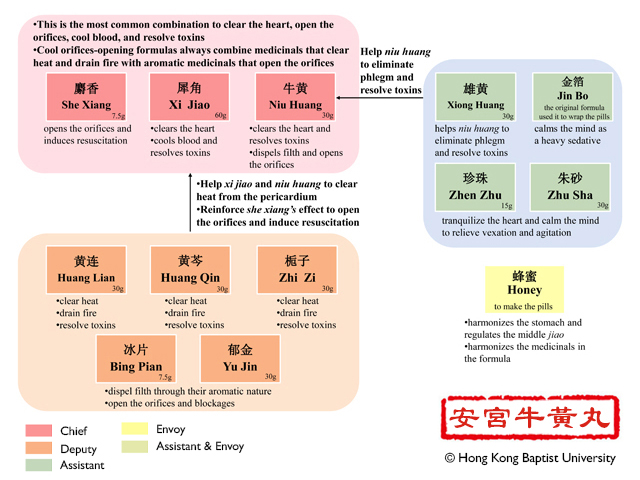NamePeaceful Palace Bovine Bezoar Pill
ClassificationResuscitative formulas
CombinationBovis Calculus (Niu Huang) 1 liang (30g), Curcumae Radix (Yu Jin) 1 liang (30g), Coptidis Rhizoma (Huang Lian) 1 liang (30g), Cinnabaris (Zhu Sha) 1 liang (30g), Gardeniae Fructus (Shan Zhi) 1 liang (30g), Realgar (Xiong Huang) 1 liang (30g), Scutellariae Radix (Huang Qin) 1 liang (30g), Bubali Cornu (Xi Jiao) 1 liang (30g) (Note: in place of xi jiao; use (60g) concentrated shui niu jiao powder), Borneolum Syntheticum (Bing Pian) 2.5 qian (7.5g), Moschus (She Xiang) 2.5 qian (7.5g), Margarita (Zhen Zhu) 5 qian (15g)
MethodGrind zhen zhu, zhu sha, and xiong huang with water or into an extremely fine powder. Grind huang lian, huang qin, shan zhi and yu jin into a fine powder. Grind niu huang, shui niu jiao, she xiang and bing pian into powder. Then mix them all together, grind, and sift. Form the powder into honey pills (originally they were wrapped with gold foil), each pill weighs 3g . Take 1 pill once daily. Children under three years old take 1/4 pill once daily, 4-6 years old take 1/2 pill once daily, or as advised by the prescribing physician. Patents including An Gong Niu Huang San, An Gong Niu Huang capsule and An Gong Niu Huang suppository should only be used when following the specified instructions.
ActionClears heat and resolves toxins, opens the orifices and induces resuscitation.
IndicationAn Gong Niu Huang Wan is indicated for a pattern of pathogenic heat invading the pericardium. The symptoms are high fever, vexation, unconsciousness, delirium, stiffness of the tongue and cold limbs. The tongue is red or crimson, and the pulse is rapid and forceful. It is also indicated for pathogenic heat causing internal block, wind strike, unconsciousness, and infantile convulsion.
PathogenesisThis pattern is caused by pathogenic heat invading the pericardium. When intense heat invades the pericardium in a warm disease pattern, the mind becomes disturbed and there is associated high fever, vexation, unconsciousness, and delirium. When the internal heat is intense, the fluids are scorched into phlegm. The orifices become blocked by the phlegm which worsens the unconscious condition. The heart opens into the tongue. When heat obstructs the heart’s orifice, the tongue becomes stiff and the patient is unable to speak. Furthermore, the deeper the heat is, the more cold the hands and feet become due to reverse flow of qi. Reverse flow of qi manifests with cold limbs, pathogenic heat causing internal block (including wind strike), unconsciousness, infantile high fever, and convulsion caused by pathogenic invading the pericardium and phlegm-heat clouding the clear orifices.
Application1. Essential pattern differentiation An Gong Niu Huang Wan is a common formula to treat heat block in the pericardium, also a typical cool formula that open the orifice. This clinical pattern is marked by unconsciousness and delirium, high fever, vexation and agitation, red or crimson. tongue, and rapid pulse. 2. Modern applications This formula may be used in the following biomedically defined disorders when the patient shows signs of heat block in the pericardium: epidemic encephalitis type B, epidemic cerebrospinal meningitis, toxic dysentery, uremia, cerebrovascular accident, hepatic coma, pulmonary encephalopathy, injury to the skull and brain, high fever and coma caused by infection or toxicity. 3. Cautions and contraindications This formula should not be taken in doses that are either too large or given for too long because it contains aromatic, cold and toxic medicinals. It should not be prescribed for patients with a greasy and white tongue coating due to cold blocking the orifices. It is prohibited during pregnancy.
Additonal formulaeNiu Huang Qing Xin Wan (Bovine Bezoar Heart-Clearing Pill 牛黃清心丸)
Remark1. Ginseng ( Panax ginseng ) is listed in the Convention on International Trade in Endangered Species of Wild Fauna and Flora (CITES) Appendix II. Its trade is allowed but subject to licensing controls. 2. Forest Musk Deer ( Moschus berezovskii ) is listed as "Endangered" in the International Union for the Conservation of Nature and Natural Resources (IUCN) Red List of Threatened Species. Also, it is listed in the Convention on International Trade in Endangered Species of Wild Fauna and Flora (CITES) Appendix II. Its trade is allowed but subject to licensing controls. (Except the populations of Afghanistan, Bhutan, India, Myanmar, Nepal and Pakistan, which are included in Appendix I) 3. Alpine Musk Deer ( Moschus sifanicus ) is listed as "Endangered" in the International Union for the Conservation of Nature and Natural Resources (IUCN) Red List of Threatened Species. Also, it is listed in the Convention on International Trade in Endangered Species of Wild Fauna and Flora (CITES) Appendix II. Its trade is allowed but subject to licensing controls. (Except the populations of Afghanistan, Bhutan, India, Myanmar, Nepal and Pakistan, which are included in Appendix I) 4. Siberian Musk Deer ( Moschus moschiferus ) is listed as "Vulnerable" in the International Union for the Conservation of Nature and Natural Resources (IUCN) Red List of Threatened Species. Also, it is listed in the Convention on International Trade in Endangered Species of Wild Fauna and Flora (CITES) Appendix II. Its trade is allowed but subject to licensing controls. (Except the populations of Afghanistan, Bhutan, India, Myanmar, Nepal and Pakistan, which are included in Appendix I) 5. All species of Rhino are threatened. They are listed as "Near threatened", "Vulnerable", "Endangered" or "Critically endangered" in the International Union for the Conservation of Nature and Natural Resources (IUCN) Red List of Threatened Species. Depend on their species and geographical range, they are listed in the Convention on International Trade in Endangered Species of Wild Fauna and Flora (CITES) Appendix I or II. The speices listed in Appendix I are highly protected, and the wild specices for commercial trade purposes are banned; the trade of speices that listed in Appendix II are allowed but subject to licensing controls.
Source《Systematic Differentiation of Warm Diseases》Wen Bing Tiao Bian《溫病條辨》
